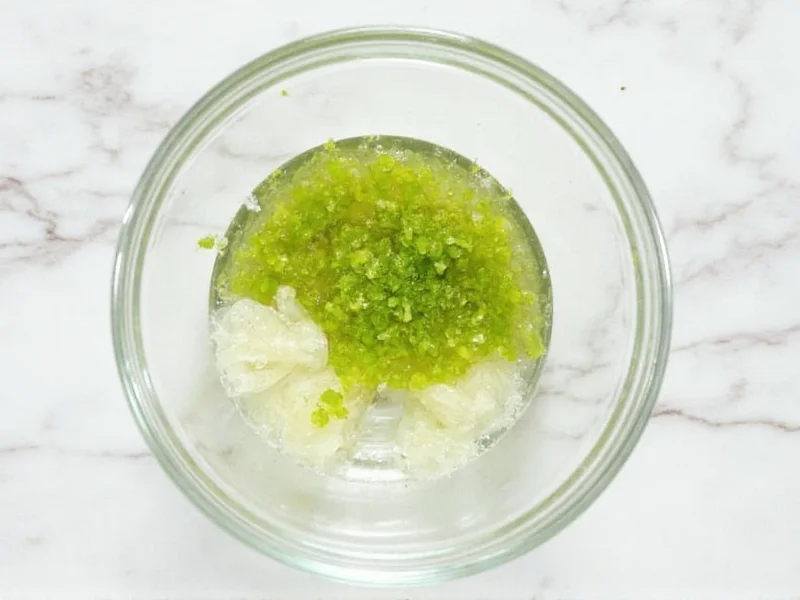The quickest and most effective way to get lime zest is by using a microplane grater or zester. Hold the lime firmly and rub it against the grater in downward motions, rotating as you go, taking care to only remove the colored outer layer (zest) while avoiding the bitter white pith underneath. One medium lime typically yields about 1-2 tablespoons of zest.
Understanding how to properly extract lime zest can transform your culinary creations. Lime zest contains concentrated citrus oils that provide intense flavor without the liquid content of juice, making it invaluable for baking, marinades, and cocktails. Unlike lime juice, which adds moisture and acidity, zest delivers pure citrus essence that enhances dishes without altering their texture.
Essential Tools for Zesting Limes
While several tools can extract lime zest, each offers different results:
| Tool | Best For | Zest Quality | Effort Required |
|---|---|---|---|
| Microplane grater | Most applications | Fine, fluffy zest | Low |
| Rasp-style zester | Decorative strips | Thin ribbons | Medium |
| Vegetable peeler | Cocktail garnishes | Wide strips | Medium |
| Box grater | When other tools unavailable | Coarse, uneven | High |
Step-by-Step Guide to Perfect Lime Zest
Follow these professional techniques to maximize your lime zest yield while maintaining quality:
- Choose ripe limes - Select firm, heavy limes with vibrant green skin. Avoid limes with yellowing skin or soft spots.
- Wash thoroughly - Scrub limes under cool running water to remove any wax or pesticides. Pat completely dry.
- Chill the lime - Refrigerate for 30 minutes before zesting. Cold limes are firmer and yield cleaner zest.
- Position correctly - Hold the lime at a 45-degree angle to your grater for optimal contact.
- Apply gentle pressure - Use short downward strokes, rotating the lime as you work. Stop immediately when you see white pith appearing.
- Collect carefully - Use a small spatula to gather zest from the grater to prevent loss.
Alternative Methods When Tools Are Unavailable
Don't have a zester? These improvised techniques work surprisingly well:
- The Fork Method: Press the tines of a fork into the lime skin and scrape downward. Works best with very sharp forks.
- Vegetable Peeler Technique: Remove thin strips of peel, then mince finely with a knife. Be meticulous to avoid the bitter pith.
- Grater Workaround: Use the smallest holes on a box grater, but go extremely slowly to prevent gouging.
- Knife Approach: Carefully shave thin layers with a paring knife, then chop into tiny pieces.
Pro Tips for Maximum Flavor and Yield
Professional chefs employ these advanced techniques when working with lime zest:
- Freeze before zesting - For exceptionally fine zest, freeze limes for 15-20 minutes (not longer, or they become too hard)
- Use organic limes when possible, as conventional limes often have wax coatings that affect flavor
- Measure properly - One medium lime typically yields 1-2 tablespoons of zest, but this varies by size and technique
- Add zest at the right time - In baking, fold zest in at the end to preserve volatile oils
- Combine with salt - A pinch of salt when zesting helps release more citrus oils
Proper Storage Methods for Fresh Lime Zest
Lime zest loses potency quickly, but these storage methods extend its shelf life:
- Short-term (1-2 days): Place zest in an airtight container lined with damp paper towel in the refrigerator
- Medium-term (2-3 weeks): Mix zest with equal parts sugar to create "citrus sugar" stored in a sealed jar
- Long-term (6+ months): Freeze zest in ice cube trays covered with water or oil, then transfer to freezer bags
- Preservation tip: Never store zest in metal containers, which can cause flavor degradation
Common Mistakes to Avoid When Zesting Limes
Even experienced cooks make these critical errors when extracting lime zest:
- Removing too much pith - The white layer beneath the zest is intensely bitter and will ruin your dish
- Using dull tools - Dull graters crush rather than cut the zest, releasing bitter compounds
- Zesting unripe limes - Underripe limes have less flavorful zest with more bitterness
- Washing and not drying - Wet limes make zest clump and become difficult to work with
- Storing improperly - Leaving zest exposed to air causes rapid flavor loss
Creative Uses for Lime Zest Beyond Cooking
Lime zest has applications that extend far beyond the kitchen:
- Cocktail enhancement - Rub zest around glass rims for aromatic cocktails
- Homemade cleaners - Combine with vinegar for natural citrus-scented cleaning solution
- DIY skincare - Mix with honey for a refreshing facial scrub (patch test first)
- Air freshener - Simmer zest with water and herbs for natural home fragrance
- Baking decoration - Freeze zest in decorative shapes for cake toppers
Understanding Lime Zest vs. Lime Juice
Many home cooks confuse these two citrus components, but they serve different culinary purposes:
- Lime zest contains the essential oils in the outer skin, providing intense citrus flavor without liquid
- Lime juice comes from the fruit's interior, adding acidity and moisture to dishes
- Flavor concentration - Zest is approximately 3-4 times more flavorful than the juice
- Substitution note - You cannot substitute juice for zest or vice versa in recipes without altering results
- Best applications - Use zest for dry ingredients and juice for liquids in recipes











 浙公网安备
33010002000092号
浙公网安备
33010002000092号 浙B2-20120091-4
浙B2-20120091-4